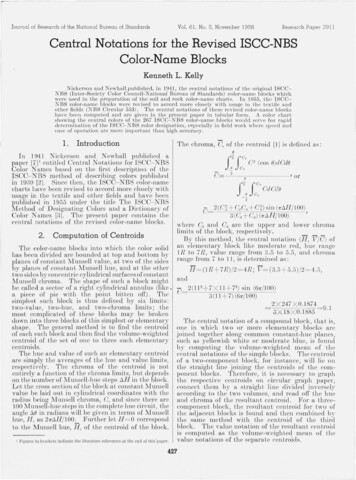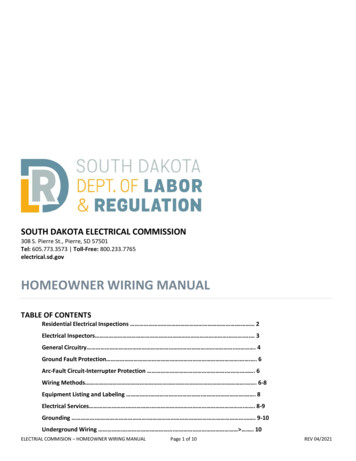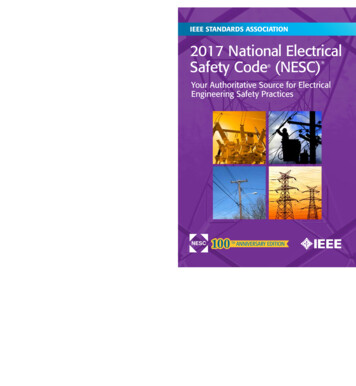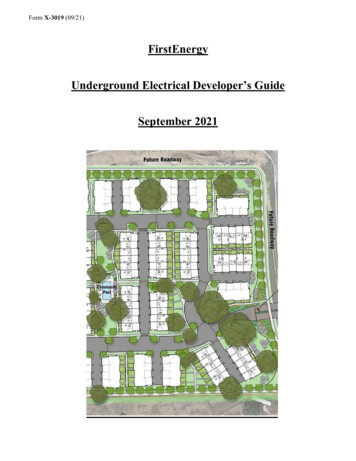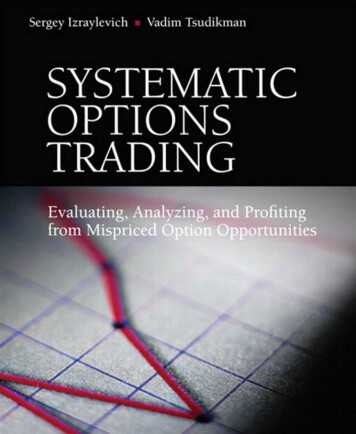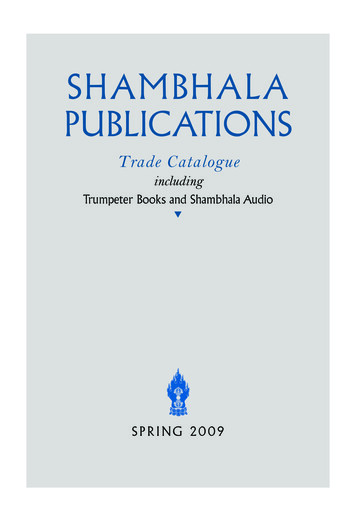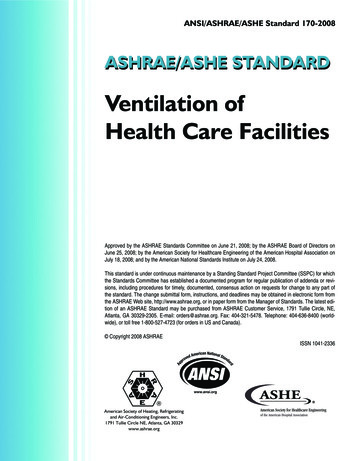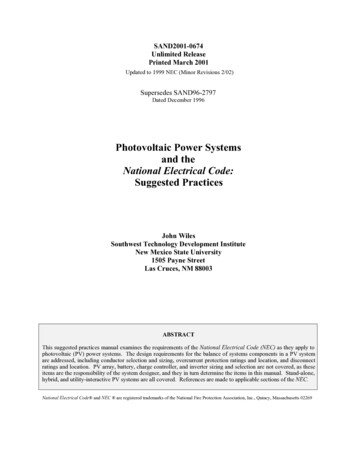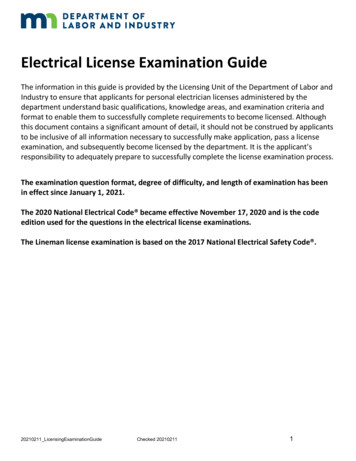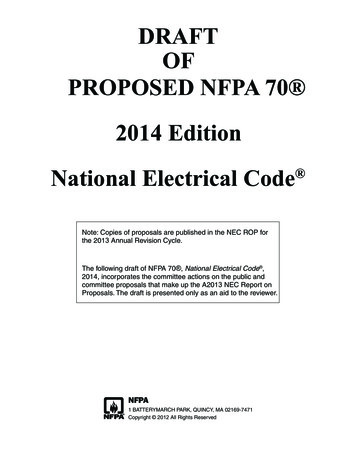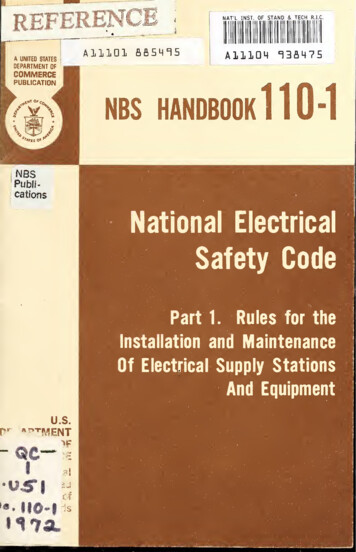
Transcription
NAT'L INST. OF STAND & TECH R.I.C.A11104A UNITED STATEST3A475NBS HANDBOOK 1 10 '1NBSPubli cationsNational ElectricalSafety CodePart 1.Rules for theInstallation and MaintenanceOf Electrical Supply StationsAnd Equipment
NATIONAL ELECTRICAL SAFETY CODEHANDBOOKSNBS Handbook 110-1 (ANSI C2.1—1971), National Electrical SafetyCode, Part 1, Rules for the Installation and Maintenance of Elec trical Supply Stations and Equipment, 1971. (Supersedes NBSHandbook H31 and pages 31-76 of NBS Handbook H30.)SD Catalog No. C13.6/2 :110-1)Price 30 cents (this publication)NBS Handbook 110-2 (ANSI C2.2) National Electrical SafetyCode, Part 2, Safety Rules for the Installation and Maintenanceof Overhead Electric Supply and Communication Lines. (In prepa ration; for current rules see NBS Handbook 81.)NBS Handbook 110-3 (ANSI C2.3) National Electrical SafetyCode, Part 3, Safety Rules for the Installation and Maintenance ofUnderground Electric Supply and Communication Lines. (In prepa ration; for current rules see NBS Handbook 81.)NBS Handbook 110-4 (ANSI C2.4) National Electrical SafetyCode, Part 4, Rules for the Operation of Electric Supply and Com munication Lines and Equipment. (In preparation; for currentrules see NBS Handbook H34, or pages 305-358 of NBS Hand book H30.)NBS Handbook 81 (ANSI C2.2—1960) including Supplement No. 1(ANSI C2.2a—1965) and Supplement No. 2 (ANSI C2.2b—1967)Safety Rules for the Installation and Maintenance of Electric Sup ply and Communication Lines, comprising Part 2, the Definitionsand the Grounding Rules of the Sixth Edition of the National Elec trical Safety Code. [Supersedes NBS Handbook H32 and Part 2(pages 77-242), the definitions (pages 1-14), and the GroundingRules (pages 15-30) of NBS Handbook H30.] SD Catalog No.C13.6/2 :81)Price 1.75Where the prices are indicated, the above Handbooks are on saleand may be ordered from the Superintendent of Documents,Government Printing Office, Washington, D. C. 20402. Order bySD Catalog Number. Checks or money orders should be madepayable to the Superintendent of Documents. Orders from for eign countries should include an additional one-fourth of thepurchase price for postage.NBS Handbook H30, National Electrical Safety Code, Fifth Edition.Note: Part 3 (pages 243-304) and Part 5 (pages 359-380) of thisHandbook have been withdrawn as American National Standards;all other parts, except Part 4, have been superseded by later pub lications. Some State and local regulations reference the NationalElectrical Safety Code edition published in NBS Handbook H30.PB No. 189052Price 3.00 hardcopy 0.65 microficheNBS Handbook H30 may be ordered from the National TechnicalInformation Service, 5285 Port Royal Road, Springfield, Virginia22151. Order by “PB” number.
!! T QA I' VS\ UNITED STATES DEPARTMENT OF COMMERCE;no. j O—jPETER G. PETERSON, SecretaryC-- I(jSNATIONAL BUREAU OF STANDARDSI tLawrenceM.Kushner,Acting DirectorNATIONAL ELECTRICAL SAFETY CODEPart 1. Rules for the Installation and Maintenanceof Electrical Supply Stations and Equipment.Approved by American National Standards InstituteJuly 14, 1971 as American National Standard C2.1—1971 bNational Bureau of Standards Handbook 110-1Supersedes NBS Handbook H31 and pp. 31 through 75of NBS Handbook H30Nat. Bur. Stand. (U.S.) Handb. 110-1, 43 pages(June 1972)CODEN: NBSNAPIssued June 1972For sale by the Superintendent of Documents, U.S. Government PrintingOffice, Washington, D.C. 20402 (Order by SD Catalog No. 13.6/2:110-1), Price 30 cents. Stock Number 0303-0992
ABSTRACTThis Handbook contains Part 1 of the National ElectricalSafety Code and supersedes NBS Handbook H31 and pages 31through 75 of the NBS Handbook H30. Part 1 of this Code covers theelectric conductors and equipment in electrical supply stations alongwith the associated structural arrangements employed, for example,by an electrical or railway utility in the exercise of its function asa utility and accessible only to properly qualified personnel. It alsocovers similar electric conductors and equipment in electrical supplystations when owned by and installed in an industrial establishment,where the electrical supply stations are under the control of andaccessible only to properly qualified persons. Examples of such indus trial establishments are the paper and steel industries.Key words: Electrical safety; electrical supply station; electricalutility station; high voltage safety; power station equipment; powerstation safety.Library of Congress Catalog Card Number: 73-183068
FOREWORDThis Handbook contains Part 1 of the sixth edition ofthe National Electrical Safety Code, dealing with the con struction and maintenance of electrical supply stations.This edition of these rules is the result of a revision car ried out according to the procedures of the AmericanNational Standards Institute. The revised text has had theapproval of ANSI Standards Committee C2, organized inconformity with this procedure, and has been recognized asan American National Standard.Criticism of the rules and suggestions for their improve ment are invited, especially from those who have experiencein their practical application. In future editions every effortwill be made to improve the rules, both in the developmentof detail and in the modification of requirements.Lawrence M. Kushner, Acting Directorhi
PREFACEThe current edition of Part 1 of the National ElectricalSafety Code was prepared by a Task Group meeting fre quently over a five-year period, from 1965-1970. This stand ard was approved under the procedures of the AmericanNational Standards Institute, after the Institute determinedthat there was a consensus for approval by the organizationsrepresented on ANSI Standards Committee C2. This Stand ard, designated as American National Standard C2.1-1971,supersedes C2.1-1939, whichwas published in NationalBureau of Standards Handbooks H30 and H31.The Code as written is a voluntary standard. However,some editions and some parts of the Code have been adopted,with and without changes, by some state and local jurisdic tional authorities. To determine the legal status of theNational Electrical Safety Code in any particular state orlocality within a state, the authority having jurisdictionshould be contacted.In preparing the first few editions of the code, theNational Bureau of Standards held meetings in many partsof the country and welcomed suggestions from everyone con cerned. The Bureau reserved to itself, however, the finaldecision on all contested points. The procedure followedin later revisions subsequent to the establishment of theAmerican National Standards Institute (formerly knownas the United States of American Standards Institute andas the American Standards Association) differs essentiallyfrom the former practice in that final decisions as to alldetails are made by the standards committees formallyapproved by the American National Standards Institute andoperating under their rules of procedure.A representative Committee on Interpretations has beenset up to prepare replies to requests for interpretation ofthe rules contained in the Code. Requests for interpretationshould state the rule in question as well as the conditionsIV
under which it is being applied. Interpretations are intendedto clarify the intent of specific rules and are not intendedto supply consulting information on the application of theCode. Requests for interpretation addressed to the BuildingResearch Division, National Bureau of Standards, Wash ington, D. C. 20234, if suitable for processing, will be sentto the Interpretations Committee. After due considerationby the Committee, which may involve many exchanges ofcorrespondence, the inquirer will be notified of its decision.v
PERSONNEL OFANSI STANDARDS COMMITTEE C2on National Electrical Safety Code(when final letter ballot was taken)Chairman, W. J. MeeseSecretary, C. K. PoarchOrganization representedName and business affiliationNational Bureau of Standards,U. S. Department of Commerce(sponsor).American Insurance Association.W. J. Meese, National Bureau ofStandards.Edward F. Steinman, Fidelity &Guaranty Company.Herbert I. Blinder, AmericanPublic Power Association.Joseph R. Arena, Sargent &Lundy, Inc.G. M. Wilhoite (alternate), Ten nessee Valley Authority.George J. Tzougros, New YorkCity Transit AuthorityHerbert J. Scheuer (alternate),American Transit Association.L. A. West, Illinois Central Rail road.C. A. Powell, Baltimore Gas andElectric Company.T. J. Brosnan, Niagara MohawkPower Corporation.C. K. Poarch (alternate), EdisonElectric Institute.C. D. Hansell, General Telephoneand Electronics Service Corpo ration.R. T. Ellis (alternate), Westinghouse Electric Corporation.A. A. Chase, Northeast UtilitiesService Company.F. A. Denbrock (alternate), Com monwealth Associates, Inc.T. W. Haymes (alternate), ShellOil Company.B. L. O’Neill, Maryland Depart ment of Labor and Industry.Edward C. La wry (alternate),Wisconsin Industrial Commis sion.American Public Power Associa tion.American Society of Civil Engi neers.American Transit Association.Association of American Rail roads.Association of Edison Illuminat ing Companies.Edison Electric Institute.Electronic Industries Association.Institute of Electrical and Elec tronic Engineers.International Association of Gov ernmental Labor Officials.VI
Standards CommitteeOrganization representedName and business affiliationInternational Brotherhood ofElectrical Workers.International MunicipalAssociation, Inc.Richard Rapattoni, InternationalBrotherhood of ElectricalWorkers.Edgar P. Grim, Electrical Bu reau, Philadelphia, Pennsyl vania.R. E. Purucker, Public ServiceCommission of Wisconsin.(vacancy)SignalNational Association of Railroadand Utilities Commissioners.National Community TelevisionAssociation, Inc.National Electrical ContractorsAssociation.Paul Henkels, Henkels & McCoy,Inc.Charles J. Hart (alternate), Na tional Electrical ContractorsAssociation.D. C. Fleckenstein, General Elec tric Company.R. F. Cook (alternate), Westinghouse Electric Corporation.L. W. Manning (alternate), Westinghouse Electric Corporation.A. L. Dowden, Liberty Mutual In surance Company.Ralph Coe (alternate), NationalSafety Council.R. E. Purucker, Public ServiceCommission of Wisconsin.James M. McCutchen, Rural Elec trification Administration.Edwin C. Kelch (alternate), Ru ral Electrification Administra tion.Harry R. Smith (alternate), Ru ral Electrification Administra tion.E. W. Glancy, American Tele phone and Telegraph Company.C. D. Hansell (alternate), Gen eral Telephone & ElectronicsService Corporation.(vacancy)National Electrical Manufactur ers Association.National Safety Council.Public Service Commission ofWisconsin.Rural Electrification Administra tion, U. S. Department of Agri culture.The Telephone Group.The Western Union TelegraphCompany.Canadian Standards Association(Liaison Representative).H.VIIL. Blacker, Bell TelephoneCompany of Canada.
TASK GROUP ON REVISION OFPART 1 OF THENATIONAL ELECTRICAL SAFETY CODEGeorge J. Yanda, Chairman (Cleveland Electric Illuminating Co., ap pointed by Edison Electric Institute)Henry J. Genther* (Rochester Gas and Electric Co., appointed byAssociation of Edison Illuminating Companies)Brian R. Jessop (Rural Electrifications Administration)William J. Meese (National Bureau of Standards)Richard R. Rapattoni (International Brotherhood of ElectricalWorkers)B. K. Sturgis (I.T.E. Circuit Breaker Co., appointed by National Elec trical Manufacturers Association).* Recently retired from his company and replaced by S. W. Hunt of Balti more Gas and Electric Company.VIII
CONTENTSPageForeword IIIPreface IVSec. A.Definitions of Special Terms1Sec. 10.Purpose, Scope and Application of the Rules100. Purpose of the Rules101. Scope of the Rules102. Application of the Rules and ExemptionsA. ApplicationB. Intent of the RulesC. Temporary Installations5556666Sec. 11.Protective Arrangements in Electrical Supply Stations110. General RequirementsA. Enclosure of EquipmentB. Rooms and Spaces1. Fireproof Construction2. Use3. Ventilation4. Moisture and WeatherC. Rotating Machinery111. IlluminationA. Under Normal ConditionsB. Emergency SourceC. FixturesD. Attachment Plugs and Receptacles for GeneralUse112. Floor, Floor Openings, Passageways, StairsA. FloorsB. PassagewaysC. RailingsD. Stair Guards113. ExitsA. Clear ExitsB. Double Exits114. Fire Extinguishing Equipment115. Oil Filled Apparatus6667777788888Sec. 12.Protective Arrangements of Equipment120. General Requirements121. InspectionsA. In-Service EquipmentB. Idle EquipmentC. Emergency EquipmentD. New Equipment122. Guarding Shaft Ends, Pulleys, Belts and SuddenlyMoving PartsA. Mechanical Transmission MachineryB. Suddenly Moving Parts123. Protective GroundingA. Protective Grounding or Isolation of Non-CurrentCarrying Metal PartsB. Grounding MethodIX8999999910101010101010111111111111111112
Electrical Supply StationsPageC.Provision for Grounding Equipment DuringRepairs124. Guarding Live PartsA. Where RequiredB. Strength of GuardsC. Types of Guards1. Location or Isolation2. Metal Cable Sheaths3. Shields or Enclosures4. Railings5. Fences6. Insulating Covering on Conductors or Parts7. Mats8. Live Parts Below Supporting Surfaces forPersons125. Working Space About Electrical Equipment126. Equipment for Work on Live PartsA. Voltages from 600 to 15,000 Volts Between PhasesB. Voltages Over 15,000 Volts Between Phases127. Hazardous LocationsA. Enclosure of Arcing and Heating PartsB. Grounding128. Identification »A. MethodB. NameplateSec. 13.Sec. otating Equipment130. Speed Control and Stopping DevicesA. Automatic Overspeed Tripping Devices for PrimeMoversB. Other Stopping DevicesC. Speed Limit for MotorsD. Low-Voltage or Under-Voltage ProtectionE. Adjustable-Speed MotorsF. Protection of Control Circuits131. Guards for Rotating EquipmentA. Moving PartsB. Live Parts132. Access to Equipment133. MotorsA. ControlB. Motors in Hazardous Locations134. Hydrogen Cooled EquipmentA. Control EquipmentB. Hydrogen StorageC. e Batteries140. General141. Location142. Ventilation143. Racks and TraysA. RacksB. Trays144. Guarding Live PartsA. Guarding222222222222222323
ContentsPageB.C.145.146.147.A.B.Bare ConductorsDetails of GuardsFloors in Battery RoomsWiring in Battery RoomsIllumination and Heating for Battery RoomsLighting FixturesHeating Appliances23232323232324Transformers and Regulators150. Current-Transformer Secondary Circuits151. Grounding Secondary Circuits of InstrumentTransformers152. Grounding of Cases153. Location and Arrangement of Power Transform ers and RegulatorsA. Outdoor InstallationsB. Indoor Installations2424242425Sec. 16.Conductors160. Electrical ProtectionA. Overcurrent Protection RequiredB. Grounded Conductors161. Mechanical Protection162. Isolation163. Conductor TerminationsA. InsulationB. Metal-Sheathed or Shielded Cable262626262626262626Sec. 17.Switches, Circuit Breakers, Fuses and Reclosers170. Arrangement171. Application172. Circuit Breakers, Switches, and Reclosers Con taining Oil173. Switches and Disconnecting DevicesA. CapacityB. Provisions for DisconnectingC. Visible Break Switch174. Disconnection of Fuses272727272828282829Sec. 18.Switchboards180. Location and AccessibilityA. General LocationB. Spaces About BoardsC. Arrangements181. Material182. Instrumentation and Control183. Arrangement and Identification184. Spacings and Barriers185. Instrument Cases29292929292929303030Sec. 19.Lightning Arresters190. General Requirements191. Indoor Locations192. Grounding Conductors193. Guarding Live Parts194. Installation303030303131Sec. 15.XI2424
SI CONVERSION UNITSIn view of present accepted practice in this country inthis technological area, common U.S. units of measurementhave been used throughout this paper. In recognition of theposition of the USA as a signatory to the General Confer ence on Weights and Measures, which gave official status tothe metric SI systems of units in 1960, conversion factorsapplicable to the U.S. units used in this paper are presentedbelow.Length1 in “ 0.0254* meter (m)1 ft 0.3048* meter (m)Electricity1 volt—SI Unit1 ampere—SI UnitPower1 watt—SI UnitLight1 foot-candle10.76391 lumens per square meter (lm/m2)* Exactly.XII
SECTION A. DEFINITIONS OF SPECIAL TERMSThe following definitions are for use with Part 1 of theNational Electrical Safety Code. For other use and fordefinitions not contained herein, see:(1)(2)NBS Handbook 81 (ANSI C2.2—1960)Definitions of Electrical Terms (ANSI C42)NOTE: Definitions of terms marked with an asterisk (*) aredefined differently in NBS Handbook 81, Safety Rules for theInstallation and Maintenance of Electric Supply and Communi cation Lines (Part 2 of the NESC). However, except in the caseof Definition A-6-CONDUCTOR, those differences are of an edi torial nature. Changing technology in the electrical field hasnecessitated a different definition for the term “CONDUCTOR.”A—1.Alive or Live means electrically connected to a source ofpotential difference, or electrically charged so as to have a potentialdifferent from that of the earth. The term “live” is sometimes usedin place of the term “current-carrying,” where the intent is clear, toavoid repetitions of the longer term.*A-2.Appliance means current-conducting,energy-consumingequipment, fixed or portable; for example, heating, cooking, and smallmotor-operated equipment.A—3.Automatic means self-acting, operating by its own mecha nism when actuated by some impersonal influence—as, for example,a change in current strength; not manual, without personal interven tion. Remote control that requires personal intervention is not auto matic, but manual.A—4.Circuit means a conductor or system of conductors throughwhich an electric current is intended to flow.*A—5,Circuit Breaker means a mechanical switching device,capable of making, carrying and breaking currents under normal cir cuit conditions and also making, carrying for a specified time andbreaking currents under specified abnormal conditions such as thoseof short circuits.*A—6.Conductor means a material usually in the form of awire, cable, or bus bar suitable for carrying an electric current.A-7.Current-Carrying Part means a conducting part intended tobe connected in an electric circuit to a source of voltage. Noncurrent carrying parts are those not intended to be so connected.*A-8.De-energized (Dead) means free from any electric con nection to a source of potential difference and from electric charge;not having a potential different from that of the earth.NOTE:The term is used only with reference to current-carrying partswhich are sometimes alive.*A—9.Disconnecting or Isolating Switch (Disconnector, Isolator)means a mechanical switching device used for changing the connec1
Electrical Supply Stations2tions in a circuit, or for isolating a circuit or equipment from a sourceof power.NOTE:It is required to carry normal load current continuously, and alsoabnormal or short-circuit currents for short intervals as specified.It is also required to open or close circuits either when negligiblecurrent is broken or made, or when no significant change in thevoltage across the terminals of each of the switch poles occurs.A—10.Effectively Grounded means permanently connected toearth through a ground connection or connections of sufficiently lowimpedence and having sufficient current-carrying capacity to preventthe building up of voltages which may result in undue hazard toconnected equipment or to persons.A—11.Electric-Supply Equipment means equipment which pro duces, modifies, regulates, controls, or safeguards a supply of electricenergy. Similar equipment, however, is not included where used inconnection with signaling systems under the following conditions:(a) Where the voltage does not exceed 150 volts.(b) Where the voltage is between 150 and 400 volts and the powertransmitted does not exceed 3 kilowatts.A—12.Electrical Supply Station means any building, room, orseparate space within which electric supply equipment is located andthe interior of which is accessible, as a rule, only to properly qualifiedpersons.NOTE:This includes generating stations and substations and generator,storage-battery, and transformer rooms.A-13.Enclosed means surrounded by a case, cage or fence, whichwill protect the contained equipment and prevent accidental contactof a person with live parts.A—14.Equipment means a general term including fittings, devices,appliances, fixtures, apparatus, and the like, used as a part of, orin connection with, an electric installation.A-15.Explosion Proof means capable of withstanding withoutinjury and without transmitting flame to the outside any explosion ofgas which may occur within.A-16.Grounded means connected to earth or to some extendedconducting body which serves instead of the earth whether the con nection is intentional or accidental.A—17.Grounded Conductor means a conductor which is inten tionally grounded, either solidly or through a current limiting device.A-18.Grounded System means a system of conductors in whichat least one conductor or point (usually the middle wire, or neutralpoint of transformer or generator windings) is intentionally grounded,either solidly or through a current-limiting device.A—19.Grounding Conductor means a conductor which is used toconnect the equipment or the wiring system with a grounding elec trode or electrodes.A-20.Guarded means covered, shielded, fenced, enclosed, orotherwise protected by means of suitable covers or casings, barrier
3Definitionsrails or screens, mats or platforms, to remove the liability of dan gerous contact or approach by persons or objects to a point of danger.NOTE:Wires which are insulated, but not otherwise protected, are notconsidered as guarded.A—21.Insulated means separated from other conducting surfacesby a dielectric substance or air space permanently offering a highresistance to the passage of current and to disruptive dischargethrough the substance or space.NOTE:When any object is said to be insulated, it isinsulated in a suitable manner for the conditionsjected. Otherwise, it is, within the purpose ofsulated. Insulating covering of conductors is onethe conductors insulated.understood to beto which it is sub these rules, unin means for makingA—22.Insulating (where applied to the covering of a conductor,or to clothing, guards, rods, and other safety devices) means thata 'device, when interposed between a person and current-carryingparts, protects the person making use of it against electric shockfrom the current-carrying parts with which the device is intendedto be used; the opposite of conducting.A—23.Isolated means that an object is not readily accessible topersons unless special means for access are used.A—24.Isolation by Elevation means elevated sufficiently so thatpersons may safely walk underneath.*A-25.Lightning Arrester means a protective device for limitingsurge voltage on equipment by discharging or by-passing surge cur rent ; it prevents continued flow of follow current to ground, and iscapable of repeating these functions as specified.NOTE:In general, arresters consist of series gaps and characteristic ele ments arranged within or upon suitable insulating members.A—26.Low Voltage Protection means the effect of a device oper ative on the reduction or failure of voltage so as to cause and main tain the interruption of power supply to the equipment protected.A-27.Manualmeans capable of being operated by personalintervention.A—28.Qualified means familiar with the construction and opera tion of the apparatus and the hazards involved.A—29.Raceway means any channel for loosely holding wires orcables in interior work, which is designed expressly and used solelyfor this purpose. Raceways may be of metal, wood, or insulatingmaterial, and the term includes wood and metal moldings consistingof a backing and capping, and also metal ducts into which wires areto be pulled.A—30.Reconstruction means replacement of any portion of anexisting installation by new equipment or construction. Does notinclude ordinary maintenance replacements.A—31.Substantial means so constructed and arranged as to beof adequate strength and durability for the service to be performedunder the prevailing conditions.A—32.Supply Station—See Electrical Supply Station.
4Electrical Supply StationsA—33.Switch means a device for opening and closing or forchanging the connection of a circuit. In these rules, a switch willalways be understood to be manually operated, unless otherwisestated.A-34.Switchboard means a type of switchgear assembly thatconsists of one or more panels with electric devices mounted thereon,and associated framework.A—35. Tags mean “men at work” tags of distinctive appear ance, indicating that the equipment or lines so marked are beingworked on.A—36, Transformer Vault means an isolated enclosure eitherabove or below ground with fire-resistant walls, ceiling, and floor,in which transformers and related equipment are installed, and whichis not continuously attended during operation.A—37. Utilization Equipment means equipment, devices, and con nected wiring which utilize electric energy for mechanical, chemical,heating, lighting, testing, or similar purposes and are not a part ofsupply equipment, supply lines, or communication lines.A—38. Voltage of an Effectively Grounded Circuit means thehighest effective voltage between any conductor and ground unlessotherwise indicated.A—39.Voltage of a Circuit Not Effectively Grounded means thehighest effective voltage between any two conductors unless otherwiseindicated.If one circuit is directly connected to another circuit of highervoltage (as in the case of an autotransformer), both are consideredas of the higher voltage, unless the circuit of lower voltage iseffectively grounded, in which case its voltage is not determinedby the circuit of higher voltage. Direct connection implies electricconnection as distinguished from connection merely through elec tromagnetic or electrostatic induction.A-40,Voltage to Ground of a Grounded Circuit means the high est effective voltage between any conductor of the circuit and thatpoint or conductor of the circuit which is grounded.A—41,Voltage to Ground of an Ungrounded Circuit means thehighest effective voltage between any two conductors of the circuitconcerned.A—42. Voltage to Ground of a Conductor of a Grounded Circuitmeans the highest effective voltage between such conductor and thatpoint or conductor of the circuit which is grounded.A—43.Voltage to Ground of a Conductor of an UngroundedCircuit means the highest effective voltage between such conductorand any other conductor of the circuit concerned.A-44.Wire Gages:—the American Wire Gage (AWG), otherwiseknown as Brown & Sharpe (B&S), is the standard gage for copper,aluminum, and other conductors, excepting steel, for which the SteelWire Gage (Stl. WG) is used throughout these rules.
5NATIONAL ELECTRICAL SAFETY CODEPart 1. Rules for the Installation and Maintenanceof Electrical Supply Stations and Equipment.SEC. 10. PURPOSE, SCOPE AND APPLICATION OFTHE RULES100:Purpose of the Rules.The purpose of Part 1 of this Code is the practical safe guarding of persons from hazards arising from the instal lation and maintenance of electrical supply stations andassociated equipment. It contains basic minimum pro visions considered necessary for safety. Compliance there with will result in an installation essentially free ofhazards. It is not intended as a design specification or asan instruction manual for untrained persons.101.Scope of the Rules.Covered:—Part 1 of this Code covers the electric conduc tors and equipment in electrical supply stations along withthe associated structural arrangements employed, for ex ample, by an electrical or railway utility in the exerciseof its function as a utility and accessible only to properlyqualified personnel. It also covers similar electric conduc tors and equipment in electrical supply stations whenowned by and installed in an industrial establishment,where the electrical supply stations are under the controlof and accessible only to properly qualified persons. Exam ples of such industrial establishments are the paper andsteel industries.Not Covered:—It does not cover installations in mines,ships, railway rolling equipment, aircraft, automotiveequipment or the conductors and equipment used primarilyfor the utilization of electric power, except those in elec trical supply stations. It does not cover installations inindustrial or commercial establishments not under thecontrol of and accessible only to properly qualified persons.Examples of such establishments are apartment houses andshopping centers.
Electrical Supply Stations6102.A.Application of the Rules and Exemptions.Application.The rules shall apply to all installations except thatthey may be modified or waived by the proper adminis trative authority when shown to be impracticable. Insuch cases, equivalent or safer construction shall besecured in other ways, including special working meth ods. Methods of construction and installation other thanthose specified in the rules may also be made as experi ments to obtain information, if done where proper super vision can be administered.B.Intent of Rules.The intent of these rules, which constitute a minimumstandard, will be realized by applying the rules in fullto all new installations, alterations, reconstructions, andextensions. Rules in this Code which are to be regardedas mandatory are characterized by the use of the Avord“shall.” Where a rule is of an advisory nature, it is indi cated by the use of the word “should.” Other practiceswhich are considered desirable but not intended to bemandatory are stated as recommendations. It is realizedthat conditions may exist which necessitate departuresfrom such recommendations. Notes contained herein arefor information
NATIONAL ELECTRICAL SAFETY CODE HANDBOOKS . NBS Handbook 110-1 (ANSI C2.1—1971), National Electrical Safety Code, Part 1, Rules for the Installation and Maintenance of Elec trical Supply Stations and Equipment, 1971. (Supersedes NBS Handbook H31 and pages 31-76 of NBS Handbook H30.
